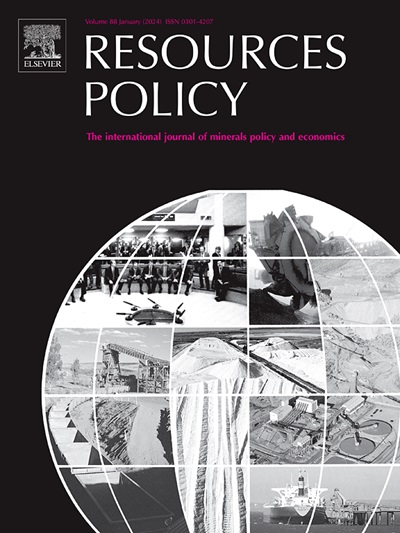Hidden mining capitalism, mineral transportation chain, and gendering livelihoods in Africa's artisanal and small-scale mining: Evidence from northern Ghana
IF 10.2
2区 经济学
0 ENVIRONMENTAL STUDIES
引用次数: 0
Abstract
Despite the artisanal and small-scale mining (ASM) literature on mineral transportation roles and gender inequalities, there has been little empirical investigation and theorization of how the mineral transportation chain perpetuates hidden labor exploitation and contributes to the gender pay gap in the sector. This paper conceptualizes “hidden mining capitalism” to explore the often concealed labor exploitation of women's work in the mineral transportation chain in Africa's ASM industry using the case of Northern Ghana. Drawing from our qualitative research, findings highlight that women's involvement in different stages of the mineral transportation chain from the extraction of the mineralized rocks (e.g. gold ore) to the crushing, shanking (i.e. sieving), milling, and washing centers are unremunerated, thus revealing socio-historically and structurally embedded dynamics of women's livelihoods, economic exploitation, and dimensions of “gendered sympathy” towards women in ASM settings. Findings also reveal that rural poverty causes increasing feminization of ASM operations, resulting in women's surplus labor that further produces several pathways for economic exploitation and unsafe working environment. Our inquiry showcases that intersectional factors (such as age, social networks, shanking experience, and ethnicity) shape women's access to transportation and processing roles as mining livelihoods to advance their economic independence and overall well-being. In exploring the above issues, we raise questions about women's role in the mineral transportation chain, particularly those related to economic exploitation (e.g. shanking) and the need for gender-sensitive on-site formalization policies.
隐藏的矿业资本主义、矿产运输链和非洲手工和小规模采矿中的性别生计:来自加纳北部的证据
尽管手工和小规模采矿(ASM)文献中有关于矿物运输角色和性别不平等的内容,但很少有关于矿物运输链如何使隐性劳动剥削长期存在并导致该部门性别工资差距的实证调查和理论。本文将“隐性矿业资本主义”概念化,以加纳北部为例,探讨非洲ASM行业中女性在矿产运输链中经常受到的隐性劳动剥削。根据我们的定性研究,研究结果强调了妇女参与矿物运输链的不同阶段,从矿化岩石(如金矿)的提取到破碎、凿槽(如筛分)、碾磨和洗涤中心都是无偿的,从而揭示了社会历史和结构上嵌入的妇女生计、经济剥削的动态,以及在ASM环境中对妇女的“性别同情”维度。研究结果还表明,农村贫困导致ASM操作的女性化加剧,导致女性剩余劳动力进一步产生经济剥削的多种途径和不安全的工作环境。我们的调查显示,交叉因素(如年龄、社会网络、吸毒经验和种族)影响了妇女获得运输和加工角色作为采矿生计的机会,从而提高了她们的经济独立性和整体福祉。在探讨上述问题时,我们提出了关于妇女在矿物运输链中的作用的问题,特别是那些与经济剥削有关的问题(例如,挖矿),以及需要对性别问题敏感的现场正式政策。
本文章由计算机程序翻译,如有差异,请以英文原文为准。
求助全文
约1分钟内获得全文
求助全文
来源期刊

Resources Policy
ENVIRONMENTAL STUDIES-
CiteScore
13.40
自引率
23.50%
发文量
602
审稿时长
69 days
期刊介绍:
Resources Policy is an international journal focused on the economics and policy aspects of mineral and fossil fuel extraction, production, and utilization. It targets individuals in academia, government, and industry. The journal seeks original research submissions analyzing public policy, economics, social science, geography, and finance in the fields of mining, non-fuel minerals, energy minerals, fossil fuels, and metals. Mineral economics topics covered include mineral market analysis, price analysis, project evaluation, mining and sustainable development, mineral resource rents, resource curse, mineral wealth and corruption, mineral taxation and regulation, strategic minerals and their supply, and the impact of mineral development on local communities and indigenous populations. The journal specifically excludes papers with agriculture, forestry, or fisheries as their primary focus.
 求助内容:
求助内容: 应助结果提醒方式:
应助结果提醒方式:


